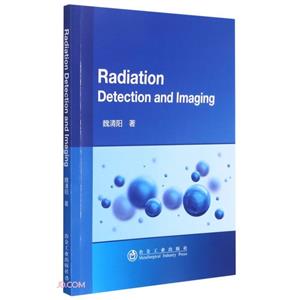扫一扫
关注中图网
官方微博
本类五星书更多>
-
>
湖南省志(1978-2002)?铁路志
-
>
公路车宝典(ZINN的公路车维修与保养秘籍)
-
>
晶体管电路设计(下)
-
>
基于个性化设计策略的智能交通系统关键技术
-
>
德国克虏伯与晚清火:贸易与仿制模式下的技术转移
-
>
花样百出:贵州少数民族图案填色
-
>
识木:全球220种木材图鉴
Radiation Detection and Imaging 版权信息
- ISBN:9787502487577
- 条形码:9787502487577 ; 978-7-5024-8757-7
- 装帧:一般胶版纸
- 册数:暂无
- 重量:暂无
- 所属分类:>
Radiation Detection and Imaging 内容简介
本书详细介绍了单一、二元及三元混合纳米流体的制备过程、稳定性、热物性参数及其强化传热机理等内容,通过对国内外纳米工质在传热领域的研究现状进行综述后,介绍了自己大量的研究成果,并对纳米工质的应用提供了详实的数据。本书研究选题新颖,切入当前相关研究领域的前沿问题和热点问题,具有显著的创新性;全书内容系统性强,著述规范,数据翔实,结果可靠。书中所报道的研究成果对设计高效换热性能的纳米工质具有现实意义,可供能源动力、冶金、化工及材料等相关领域感兴趣的研究人员参考。
Radiation Detection and Imaging 目录
1 Radiation Detection Technique using Smartphones
1.1 Introduction
1.2 Raydose-V1 App
1.2.1 Real-time Processing Algorithm
1.2.2 Dose Calibration Experiments
1.2.3 Performance Experiments
1.2.4 Results
1.2.5 Discussions
1.3 Raydose-V2
1.3.1 Image Processing Algorithms
1.3.2 Experiments
1.3.3 Result and Discussion
1.3.4 Summary
References
2 Radiation Detection Techniques using Surveillance Cameras
2.1 Introduction
2.2 Experiments
2.3 Algorithm
2.3.1 Moving-object Detection and Removal
2.3.2 Grayscale Processing and Gaussian Convolution
2.3.3 Inter-Frame Difference
2.3.4 Image Morphology Processing
2.3.5 Radiation-Information Extraction
2.4 Results
2.5 Discussion
2.6 Summary
References
3 A High Sensitivity NaI(TI) Spectrometry
3.1 Introduction
3.2 System Description
3.3 Experiments
3.4 Data Processing and Analysis
3.5 Results
3.5.1 Energy Shift of the Electronics
3.5.2 Average Pulse Waveforms
3.5.3 Energies of APWs
3.5.4 Energy Spectra
3.5.5 Energy Resolutions
3.6 Discussion and Conclusion
References
4 Radiation Location and Imaging using Scintillator Detectors
4.1 System 1 : An Attenuation based Sandwich Detector
4.1.1 Detector Scheme
4.1.2 Mathematical Model
4.1.3 Virtual Case Study
4.1.4 Experimental Results
4.1.5 Error Analysis
4.1.6 Summary
4.2 System 2: A 360 Degree Sensitive Detector
4.2.1 Description of the Design
4.2.2 Source Locating Algorithm
4.2.3 Verified Experiments
4.2.4 Experimental Results
4.2.5 Summary
4.3 System 3: A Direction-Sensitive Spherical Detector with 4π View
4.3.1 Description of the Design
4.3.2 System Components
4.4 System 4: A Coded-Aperture Camera for Radiation Imaging
4.4.1 Introduction
4.4.2 The MURA Mask
4.4.3 Scintillator Detector
4.4.4 Image Reconstruction
4.4.5 Radiation Imaging Studies
4.4.6 Image Registration
4.4.7 Summary
References
5 Nuclear Medical Imaging System
5.1 Introduction
5.1.1 Medical Imaging Technology
5.1.2 Molecular Imaging
5.1.3 Small Animal Imaging
5.2 SPECT Imaging
5.3 PET and PET/CT Imaging
5.4 A Compact Animal PET/SPECT/CT System
5.4.1 System Setup
5.4.2 Performance Evaluation
5.4.3 Results
5.4.4 Discussion and Conclusion
References
6 Intrinsic Radiation of Lutetium Based PET Detector
6.1 Introduction of Lutetium-176
6.2 The Drawbacks of IRL in PET
6.2.1 Common PET Imaging
6.2.2 Low Activity PET Imaging
6.2.3 Long Axial FOV PET
6.2.4 PET/SPECT Imaging
6.3 The Traditional Benefits of IRL in PET Systems
6.3.1 For Detector Study
6.3.2 For Monitoring PET Channel Gain Drift
6.3.3 For Time Alignment of TOF-PET
6.3.4 For Generating Transmission Image
6.4 For Pinhole Geometry Calibration
6.4.1 Lu-176 Based Calibration Method
6.4.2 Simulation Studies and Results
6.4.3 Experiment Studies and Results
6.5 For PET/CT Alignment
6.5.1 Introduction of PET/CT Alignment Calibration
6.5.2 Materials and Experiments
6.5.3 Transformation Matrix Generation Algorithm
6.5.4 Results
6.5.5 Discussions
6.5.6 Summary
6.6 Conclusions
References
7 High Performance Position Sensitive Scintillator Detectors for PET
7.1 Components of Detectors
7.1.1 Seintination Crystal Selection
7.1.2 Photodetector Selection
7.1.3 ASIC Chip
7.2 Experiment Platform
7.3 Detector Modules
7.3.1 8×8 Array Detector Module
7.3.2 12×12 Array Detector Module
7.3.3 16×16 Array Detector Module
7.3.4 22×22 Array Detector Module
7.4 PET Detectors with Air-gapped Pixelated LYSO
7.4.1 Single Crystal Experiment
7.4.2 8×8 LYSO Module Experi
1.1 Introduction
1.2 Raydose-V1 App
1.2.1 Real-time Processing Algorithm
1.2.2 Dose Calibration Experiments
1.2.3 Performance Experiments
1.2.4 Results
1.2.5 Discussions
1.3 Raydose-V2
1.3.1 Image Processing Algorithms
1.3.2 Experiments
1.3.3 Result and Discussion
1.3.4 Summary
References
2 Radiation Detection Techniques using Surveillance Cameras
2.1 Introduction
2.2 Experiments
2.3 Algorithm
2.3.1 Moving-object Detection and Removal
2.3.2 Grayscale Processing and Gaussian Convolution
2.3.3 Inter-Frame Difference
2.3.4 Image Morphology Processing
2.3.5 Radiation-Information Extraction
2.4 Results
2.5 Discussion
2.6 Summary
References
3 A High Sensitivity NaI(TI) Spectrometry
3.1 Introduction
3.2 System Description
3.3 Experiments
3.4 Data Processing and Analysis
3.5 Results
3.5.1 Energy Shift of the Electronics
3.5.2 Average Pulse Waveforms
3.5.3 Energies of APWs
3.5.4 Energy Spectra
3.5.5 Energy Resolutions
3.6 Discussion and Conclusion
References
4 Radiation Location and Imaging using Scintillator Detectors
4.1 System 1 : An Attenuation based Sandwich Detector
4.1.1 Detector Scheme
4.1.2 Mathematical Model
4.1.3 Virtual Case Study
4.1.4 Experimental Results
4.1.5 Error Analysis
4.1.6 Summary
4.2 System 2: A 360 Degree Sensitive Detector
4.2.1 Description of the Design
4.2.2 Source Locating Algorithm
4.2.3 Verified Experiments
4.2.4 Experimental Results
4.2.5 Summary
4.3 System 3: A Direction-Sensitive Spherical Detector with 4π View
4.3.1 Description of the Design
4.3.2 System Components
4.4 System 4: A Coded-Aperture Camera for Radiation Imaging
4.4.1 Introduction
4.4.2 The MURA Mask
4.4.3 Scintillator Detector
4.4.4 Image Reconstruction
4.4.5 Radiation Imaging Studies
4.4.6 Image Registration
4.4.7 Summary
References
5 Nuclear Medical Imaging System
5.1 Introduction
5.1.1 Medical Imaging Technology
5.1.2 Molecular Imaging
5.1.3 Small Animal Imaging
5.2 SPECT Imaging
5.3 PET and PET/CT Imaging
5.4 A Compact Animal PET/SPECT/CT System
5.4.1 System Setup
5.4.2 Performance Evaluation
5.4.3 Results
5.4.4 Discussion and Conclusion
References
6 Intrinsic Radiation of Lutetium Based PET Detector
6.1 Introduction of Lutetium-176
6.2 The Drawbacks of IRL in PET
6.2.1 Common PET Imaging
6.2.2 Low Activity PET Imaging
6.2.3 Long Axial FOV PET
6.2.4 PET/SPECT Imaging
6.3 The Traditional Benefits of IRL in PET Systems
6.3.1 For Detector Study
6.3.2 For Monitoring PET Channel Gain Drift
6.3.3 For Time Alignment of TOF-PET
6.3.4 For Generating Transmission Image
6.4 For Pinhole Geometry Calibration
6.4.1 Lu-176 Based Calibration Method
6.4.2 Simulation Studies and Results
6.4.3 Experiment Studies and Results
6.5 For PET/CT Alignment
6.5.1 Introduction of PET/CT Alignment Calibration
6.5.2 Materials and Experiments
6.5.3 Transformation Matrix Generation Algorithm
6.5.4 Results
6.5.5 Discussions
6.5.6 Summary
6.6 Conclusions
References
7 High Performance Position Sensitive Scintillator Detectors for PET
7.1 Components of Detectors
7.1.1 Seintination Crystal Selection
7.1.2 Photodetector Selection
7.1.3 ASIC Chip
7.2 Experiment Platform
7.3 Detector Modules
7.3.1 8×8 Array Detector Module
7.3.2 12×12 Array Detector Module
7.3.3 16×16 Array Detector Module
7.3.4 22×22 Array Detector Module
7.4 PET Detectors with Air-gapped Pixelated LYSO
7.4.1 Single Crystal Experiment
7.4.2 8×8 LYSO Module Experi
展开全部
书友推荐
本类畅销
-
黑科技驱动世界的100项技术
¥21.9¥69.8 -
黑科技:驱动世界的100项技术(八品)
¥21.9¥69.8 -
指火控弹道与射击诸元理论
¥38.7¥49 -
智能照明工程手册
¥29.9¥49.8 -
光电直读光谱分析技术与应用
¥38.7¥49 -
服务型制造
¥76.3¥109





















